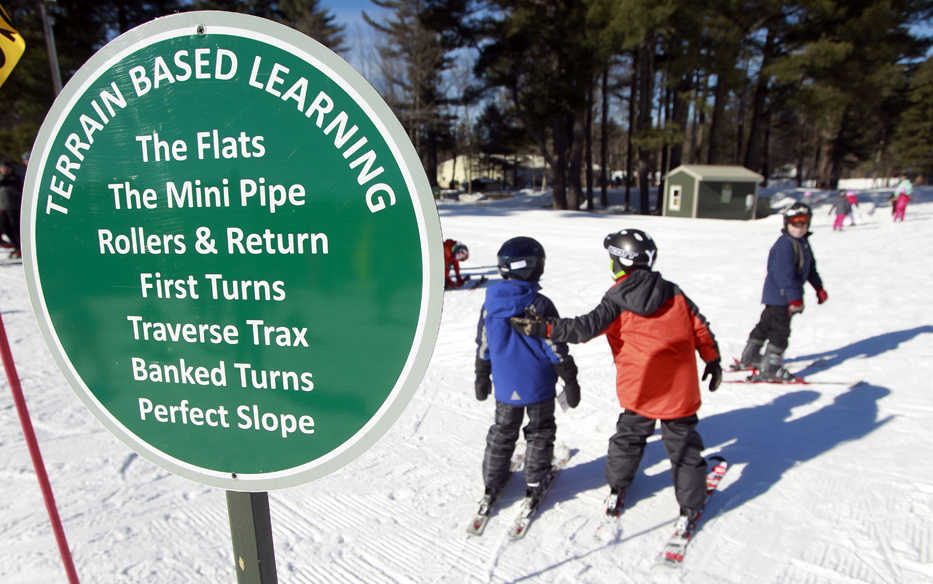NORTH CONWAY, N.H. — Allison Willette’s first few skiing lessons left her with a sore butt and aching knees but not a lot of skills. But one day’s worth of terrain-based learning made all the difference.
“Yesterday was probably the first day that I enjoyed it,” she said.
The instruction Willette got at Cranmore Mountain Resort is a new approach that uses sculpted zones to control students’ speed and reduce fears and falls. Without worrying about sliding down the mountain out of control, students can focus on building skills because the banks, berms and bumps naturally slow them down.
That means less emphasis on “snowplowing,” or pointing the skis into a wedge shape to slow down. Less time learning to stop, more time learning to go.
“Back in the good old days, we used to get people into a wedge right off the jump, but the wedge was more of a defensive posture, something to slow down and stop with,” said instructor Dave Bartlett. “But we were kind of resisting the forces we’re working with.”
The new method puts the emphasis on shaping those forces, Bartlett said, getting students more comfortable more quickly.
Willette, of Hadley, Mass., tried it out last month with her 8-year-old son. He had never been on skis; the few times she had she’d always felt intimidated. Both made quick progress.
“It allowed you to physically feel what the turn should feel like, and then you just naturally push in the right direction. So you kind of disengage your brain, and you can do it,” she said. “I learned quickly how to make turns there, and I was able to apply that to the flatter field.”
Students start out on flat snow, getting a feel for their skis. The next zone is a mini-pipe, where they slide down one side of a gentle, U-shaped slope and part way up the other. The slope is a bit steeper in the “roller” zone, which is followed by a short section of trail with banks and berms that guide students through three turns. The “traverse trax” zone includes eight turns and is the last stop before students head to the chairlift to try out a beginner trail.
Cranmore, along with Vermont’s Bromley Mountain and Jiminy Peak in Massachusetts, is one of three New England resorts that partnered with the consulting firm Snow Operating LLC to start terrain-based learning this year. Others that have adopted the approach in recent years include Breckenridge and Vail in Colorado, Northstar in California and Mountain Creek in New Jersey.
Kelly Coffey, training manager for the Breckenridge Ski and Ride School, said he has seen a marked improvement in his students, sometimes even before they actually try out the course. A family of four who took a lesson around Christmas were visibly nervous when they put on their skis, but by the time he finished explaining the zones, they were more relaxed.
“I could just see the tension in their bodies just flow out,” said Coffey, who also is a freestyle specialist for the Professional Ski Instructors of America. “From then on, I was able to get them to move a lot easier, and more gracefully, and we could progress more quickly. There were times I wanted them to turn, and they didn’t accomplish it, but they didn’t panic.”
Karen Dolan, director of Cranmore’s snowsports school, said she has seen many trends come and go during her 40 years in the industry, but she believes terrain-based learning has sticking power because it makes learning more fun. And boosting the fun factor makes it more likely that students will return — a key motivator for Cranmore and other resorts given that nationally, 85 percent of skiers never try it again after their first outing.
Mountain Creek saw its so-called conversion rate rise from 17 percent to 65 percent after implementing terrain-based learning. It remains to be seen whether Cranmore will see a similar increase, but Dolan said that kind of improvement would more than justify the $37,500 expense of building and maintaining the new terrain zones. In the meantime, the entire resort, including groomers, snow-makers, instructors and managers, is getting used to the new program.
“They all have to be part of this culture change and understand why we’re doing it. It’s everybody’s job to convert skiers and riders,” she said. “They’re here, marketing spent a lot of time getting them here, so let’s make sure that they’re having fun.”
First-time skiers and snowboarders can try terrain-based learning for free on March 9 at the three New England resorts if they register in advance. The promotion, limited to 150 people at each resort, includes equipment rental, helmet rental, a lesson and a beginner’s lift ticket.

